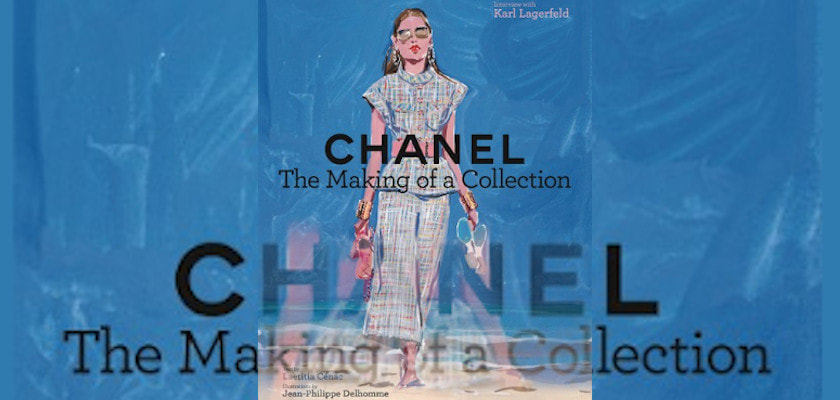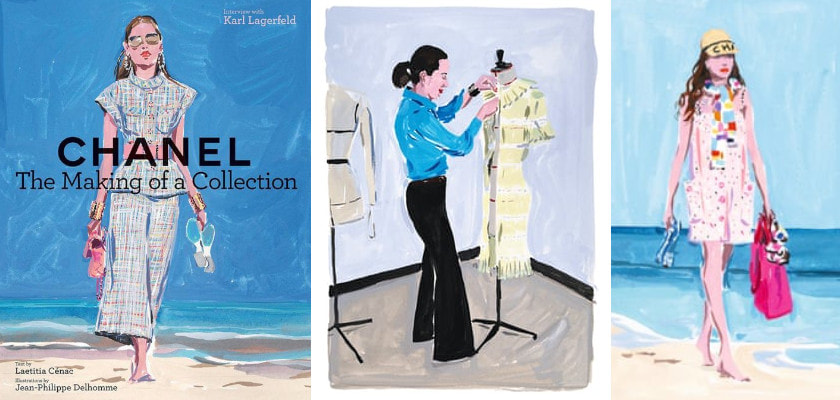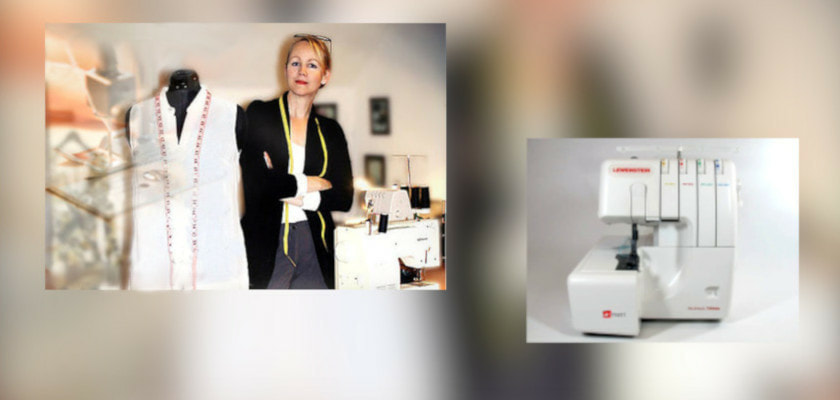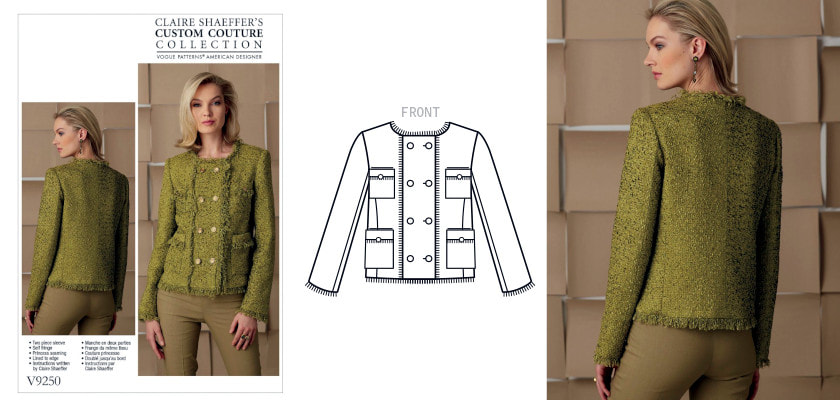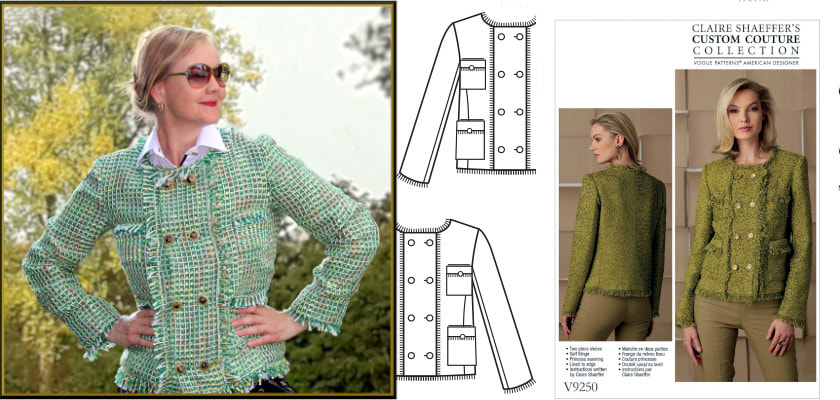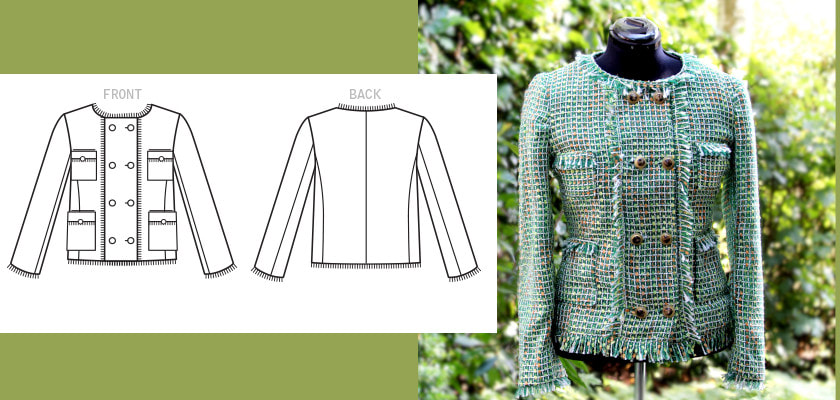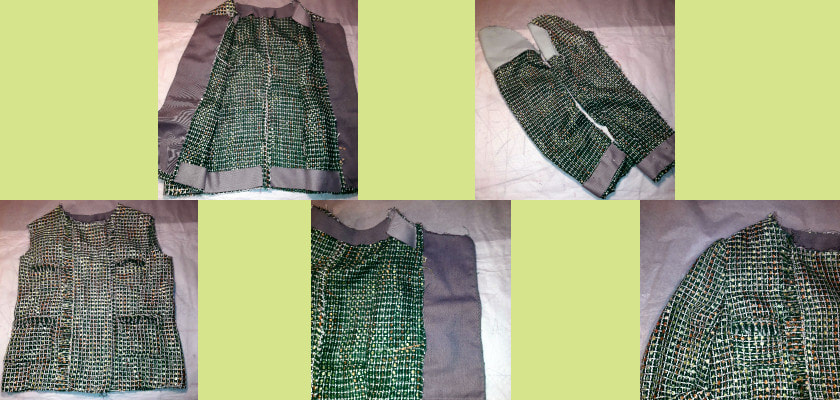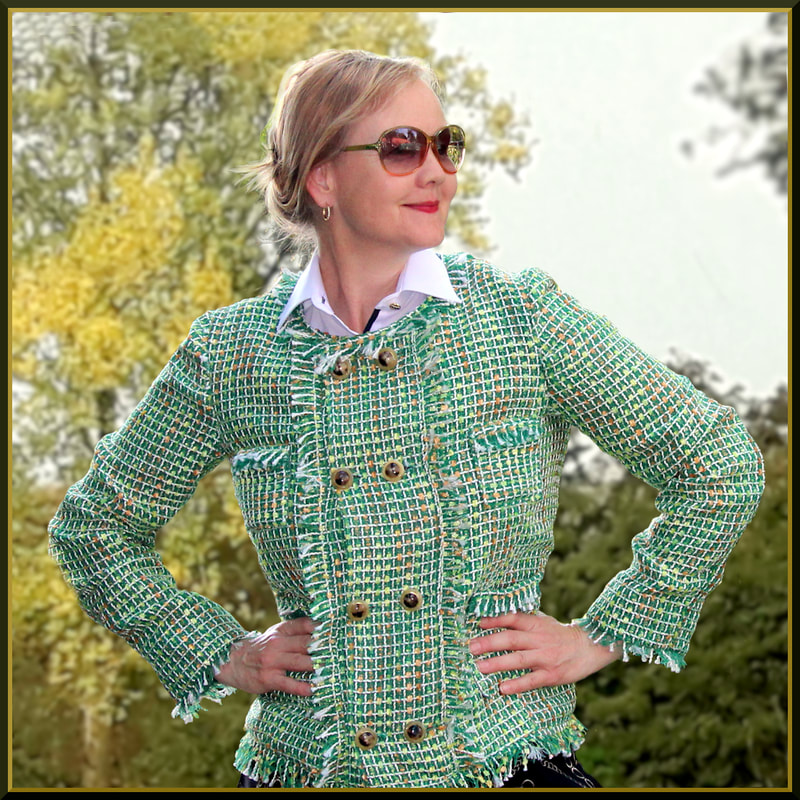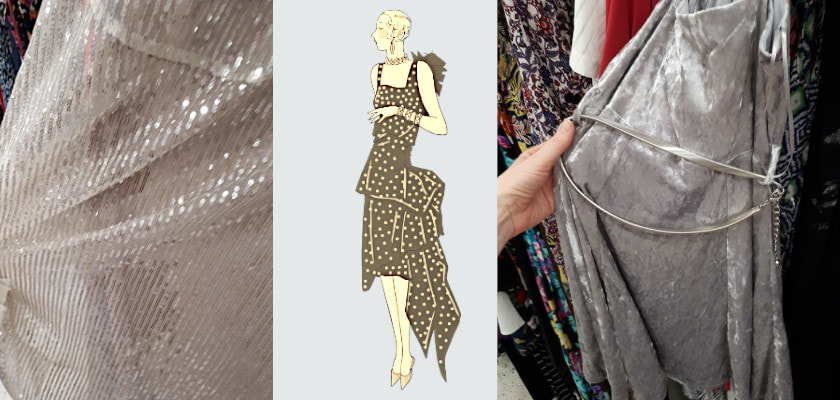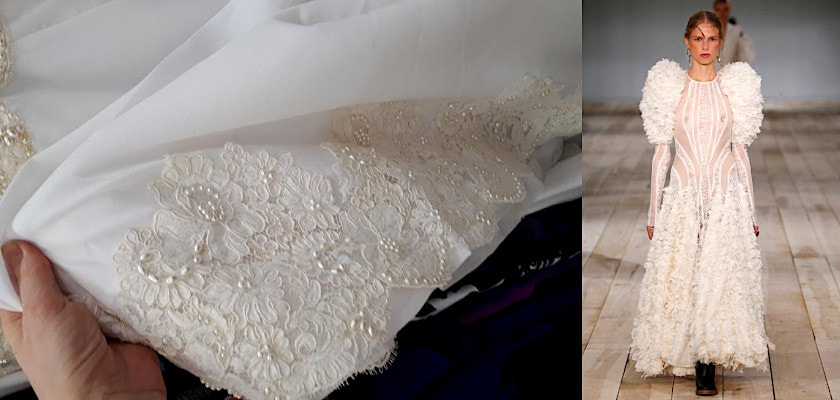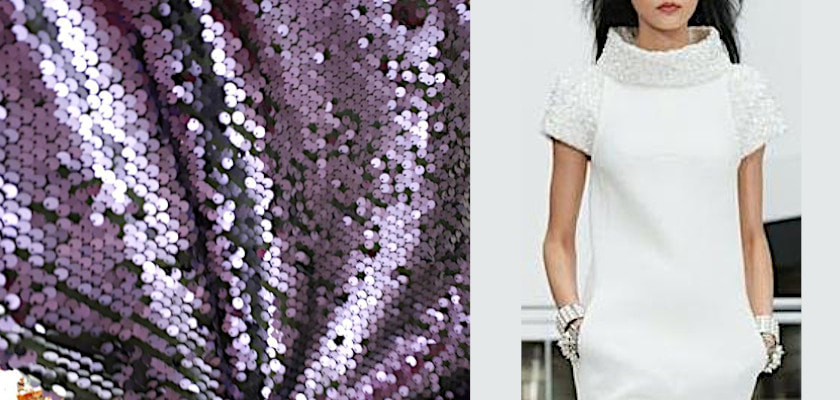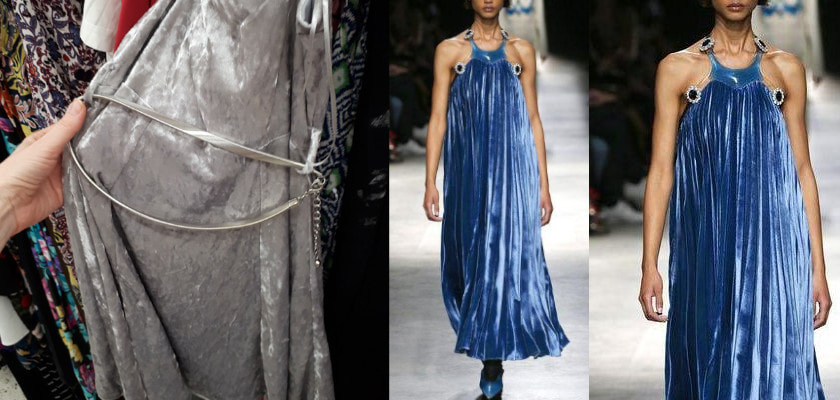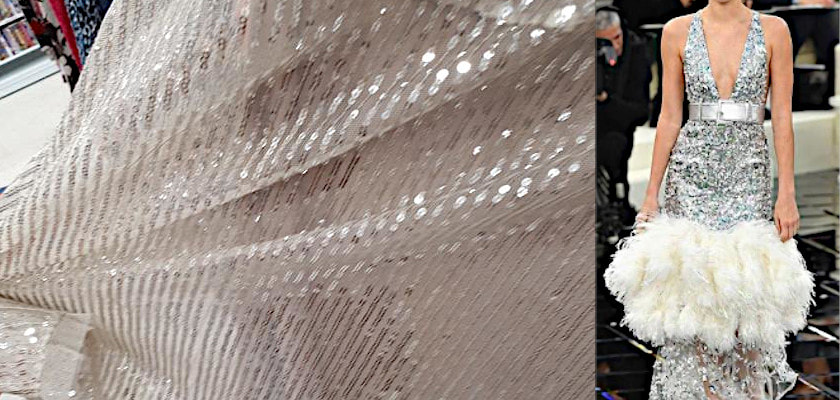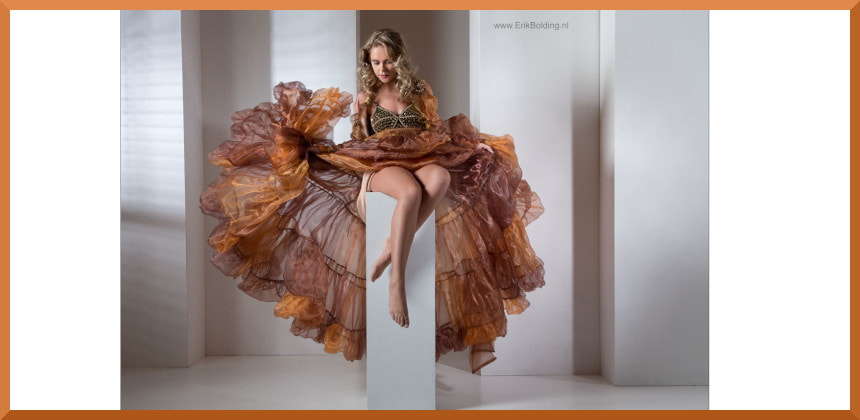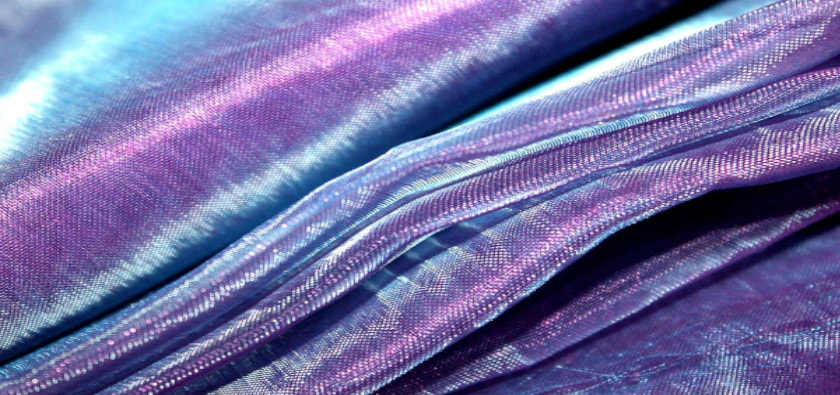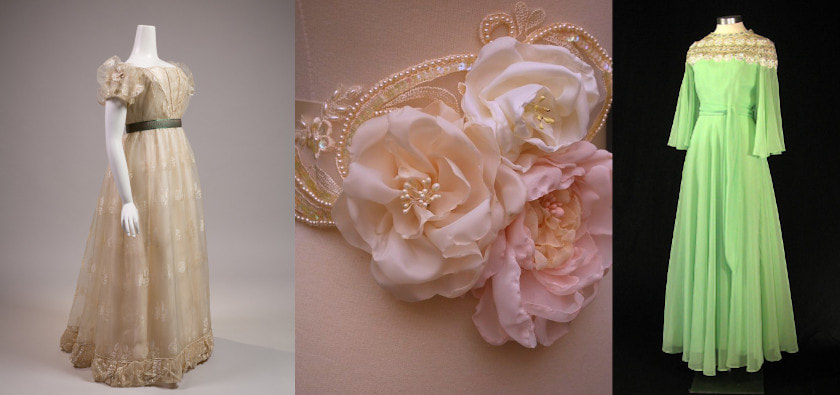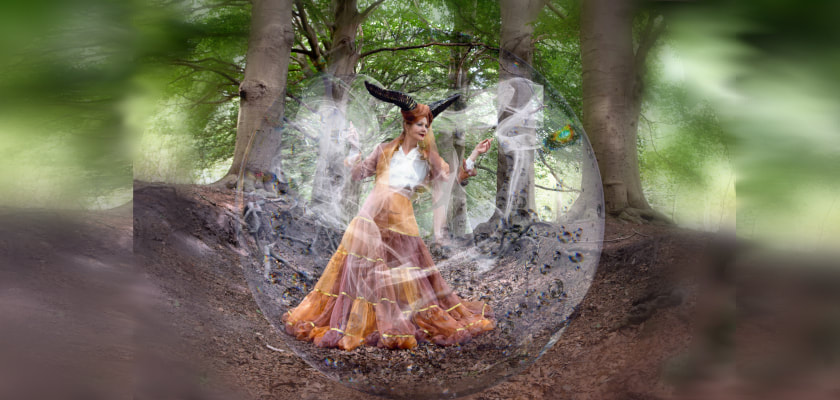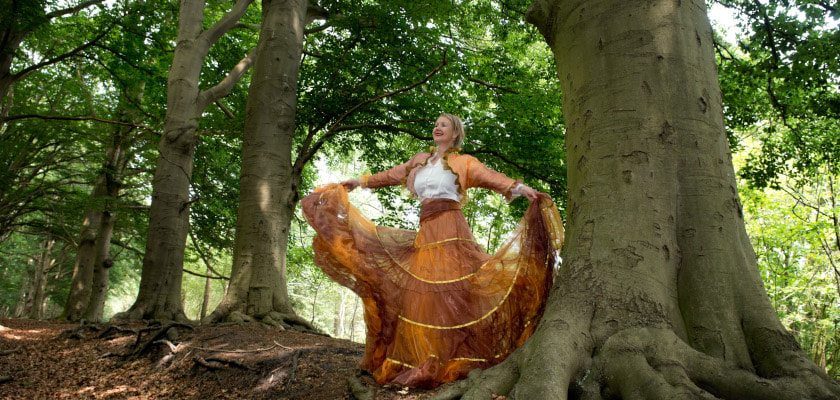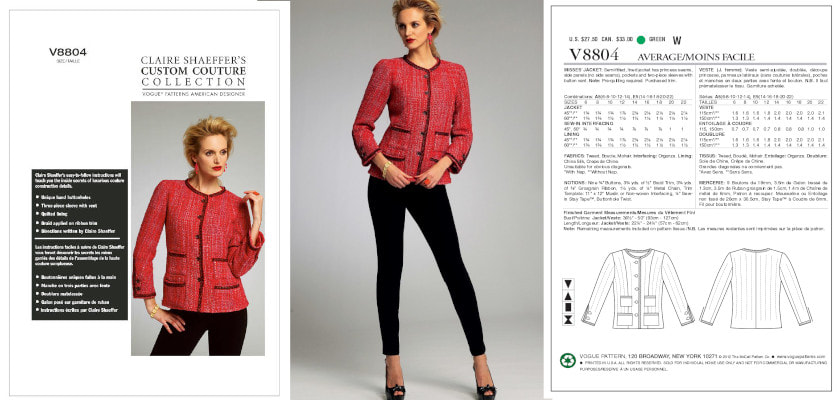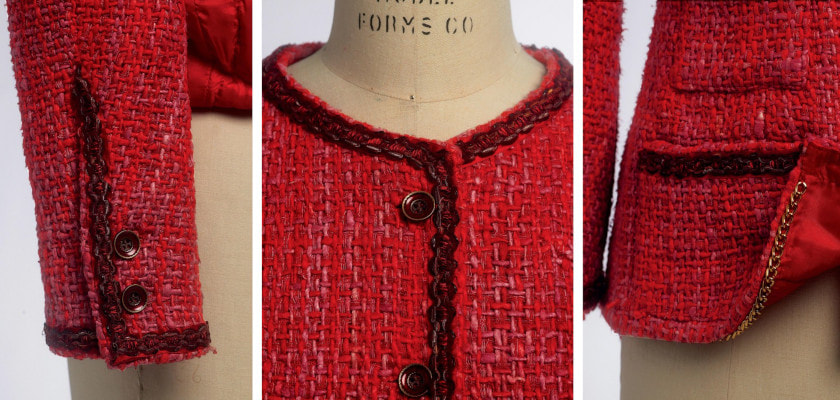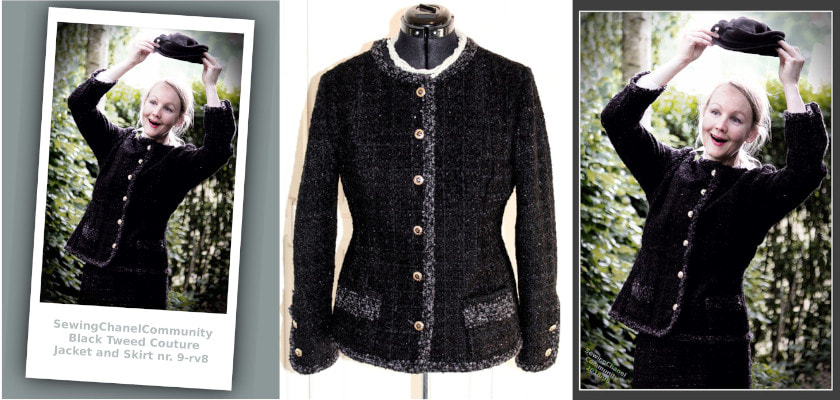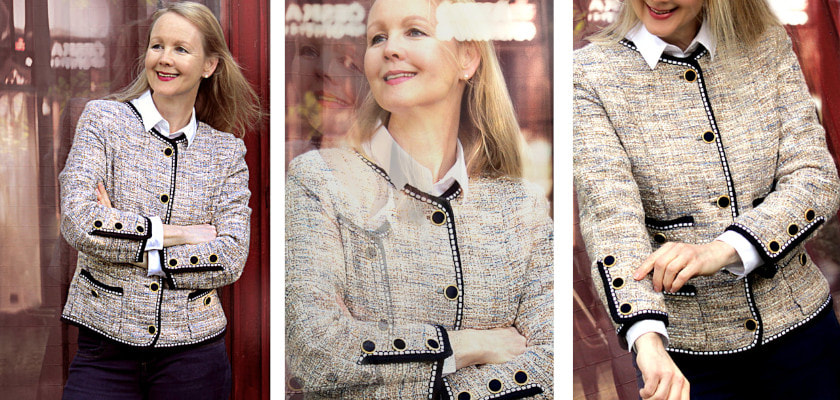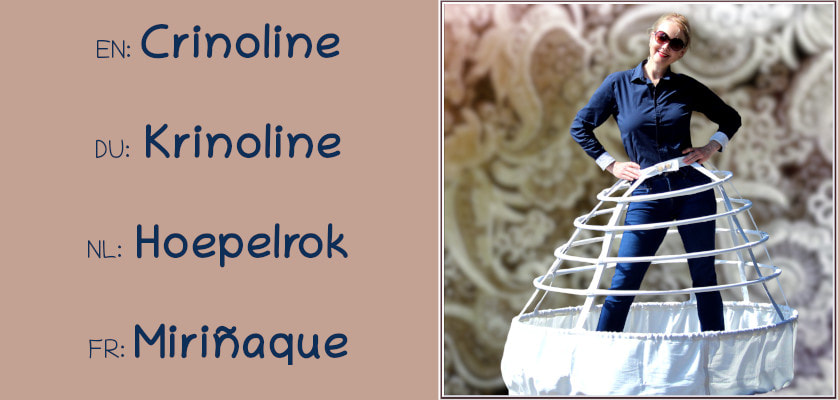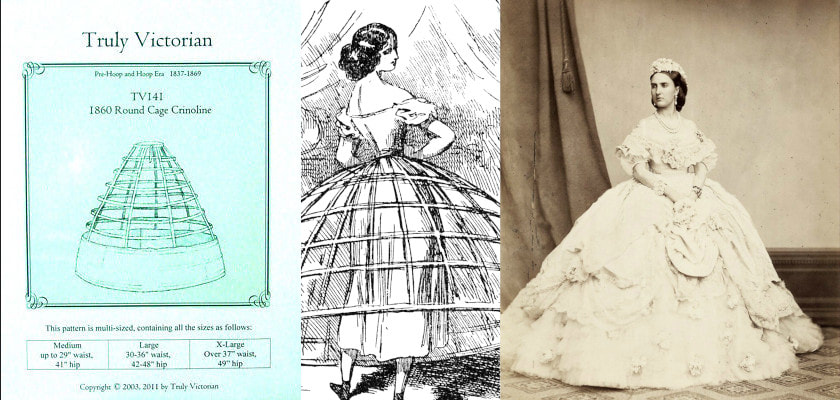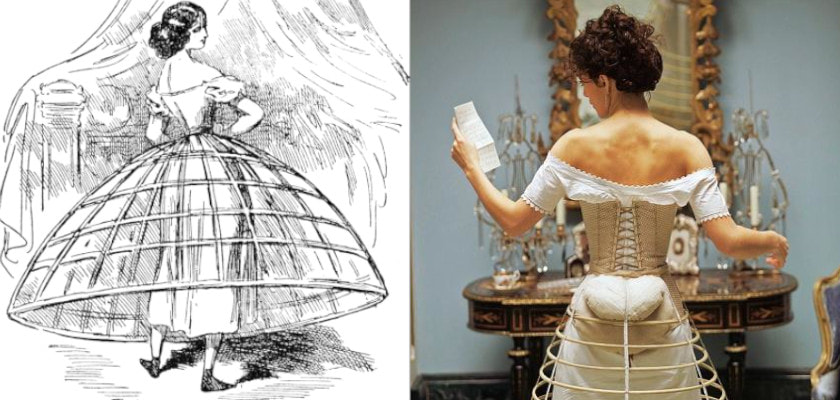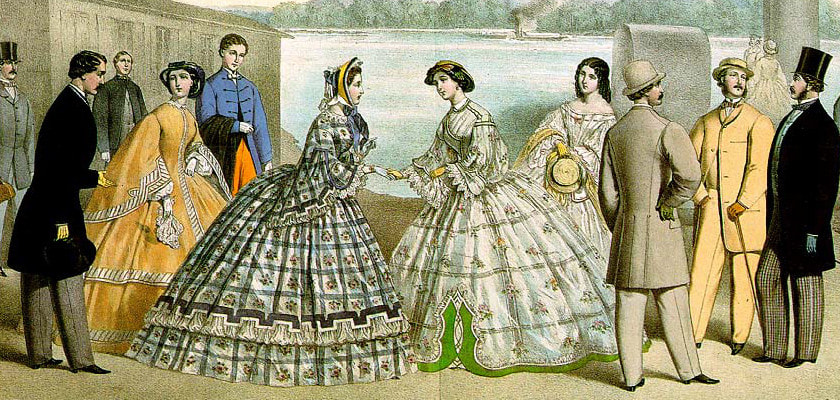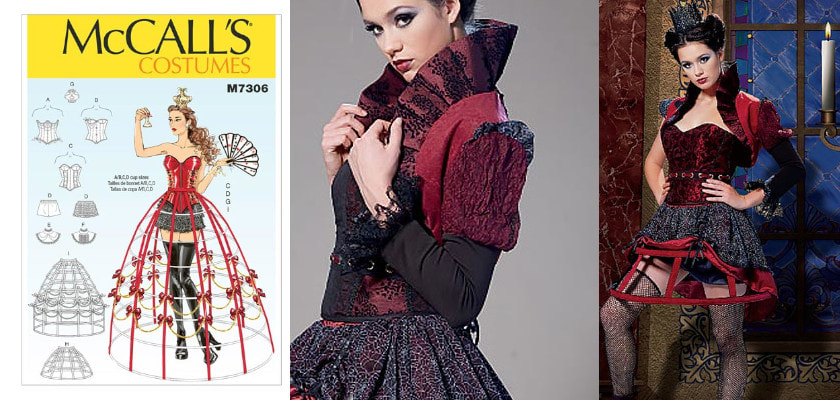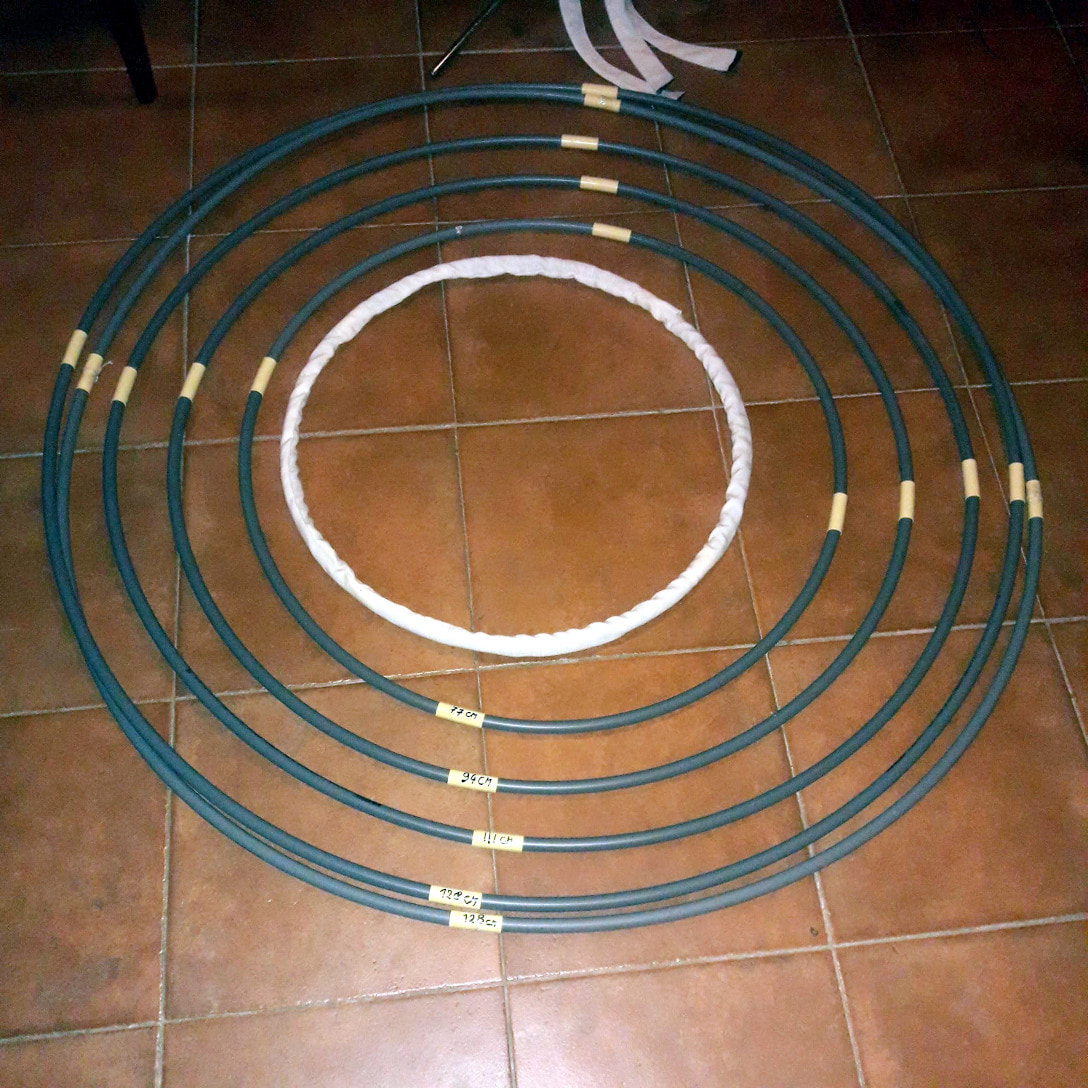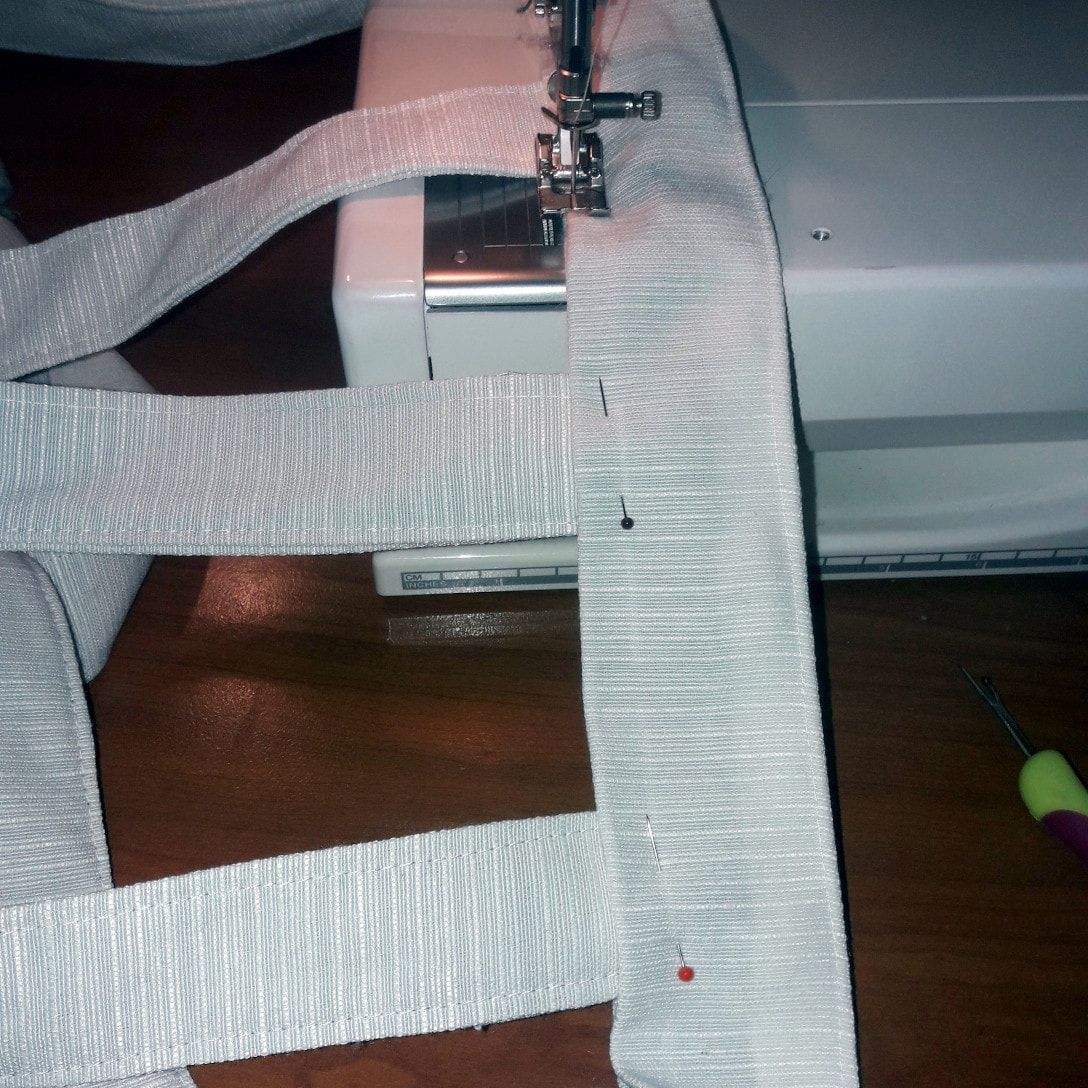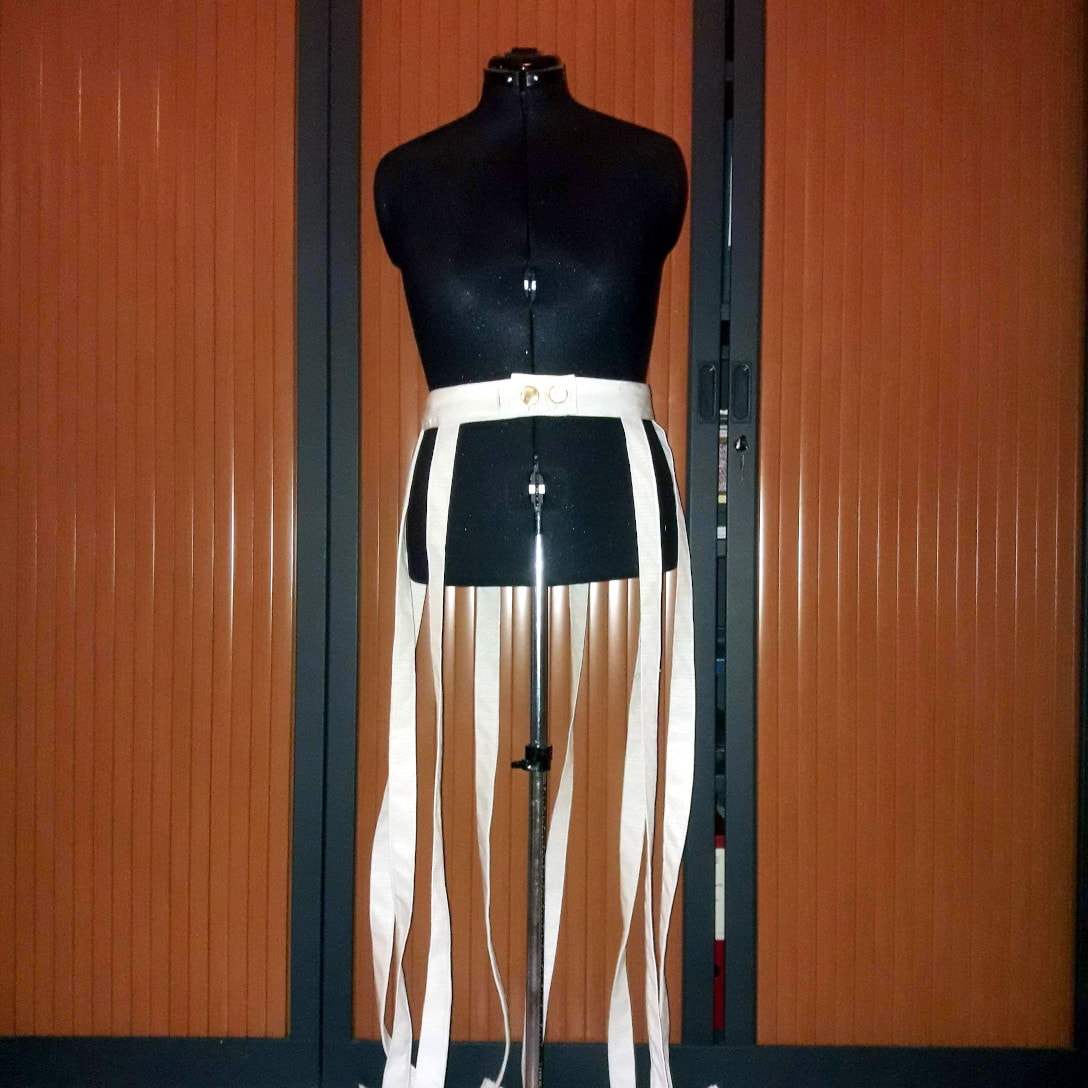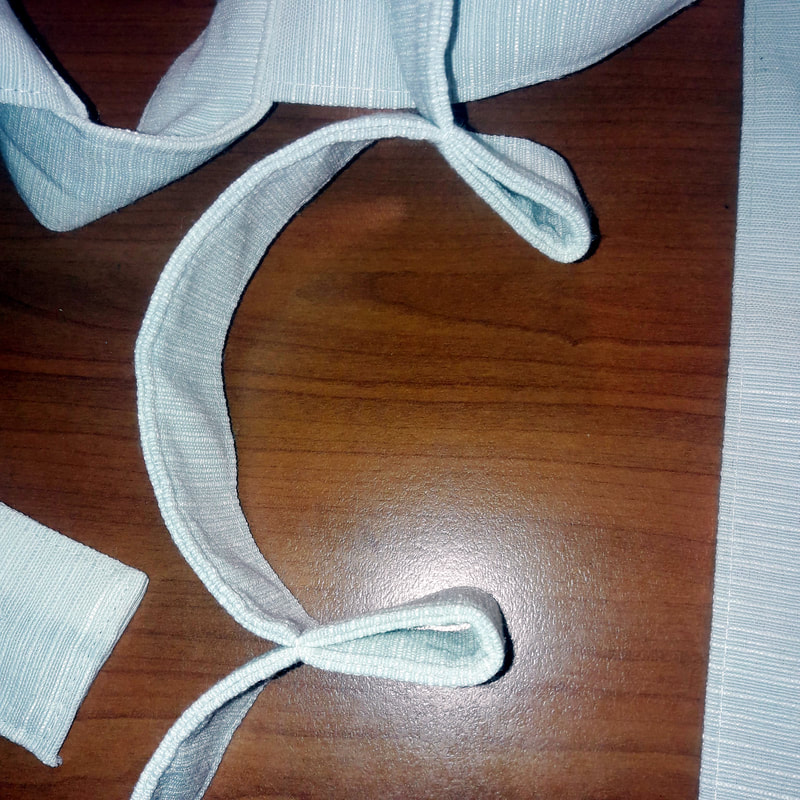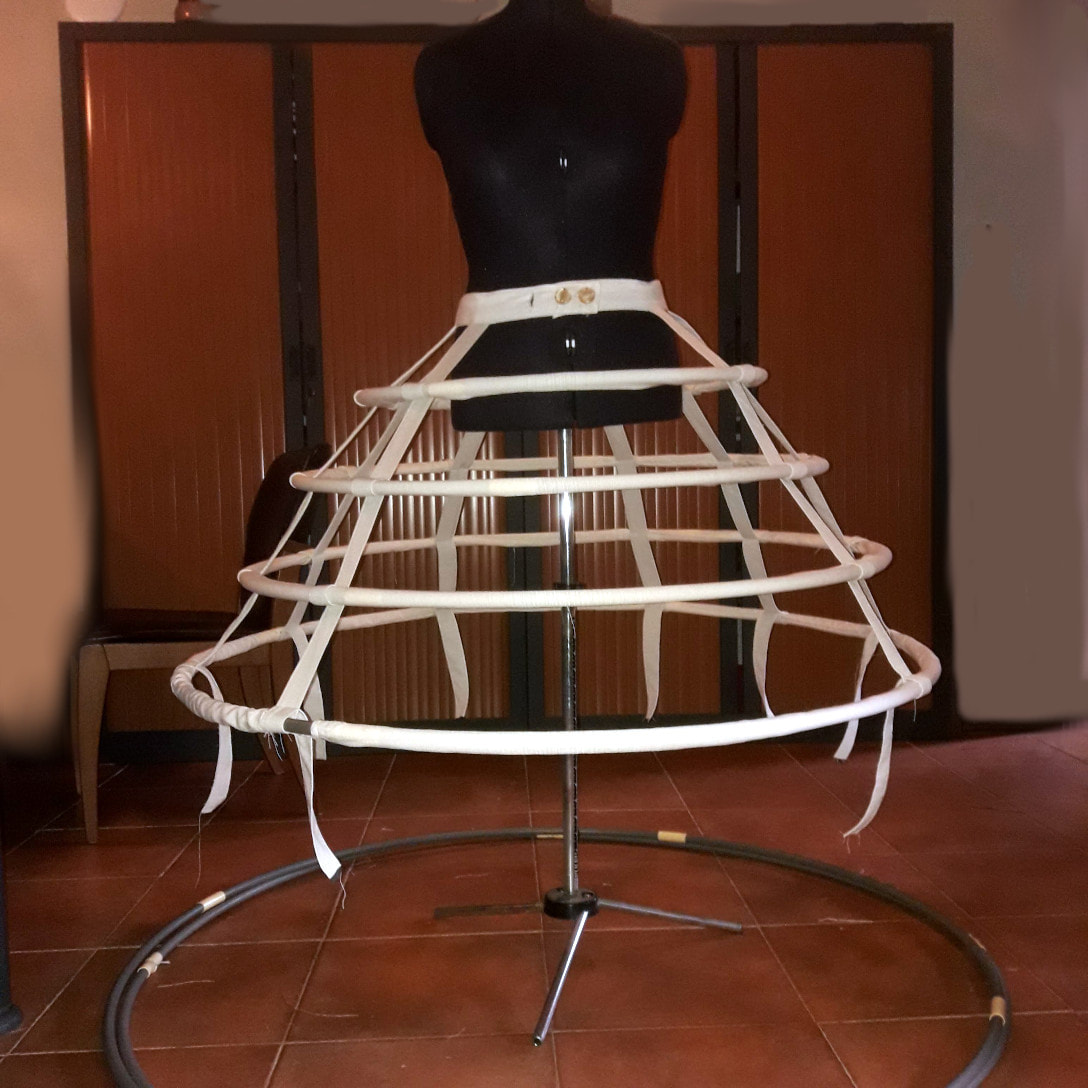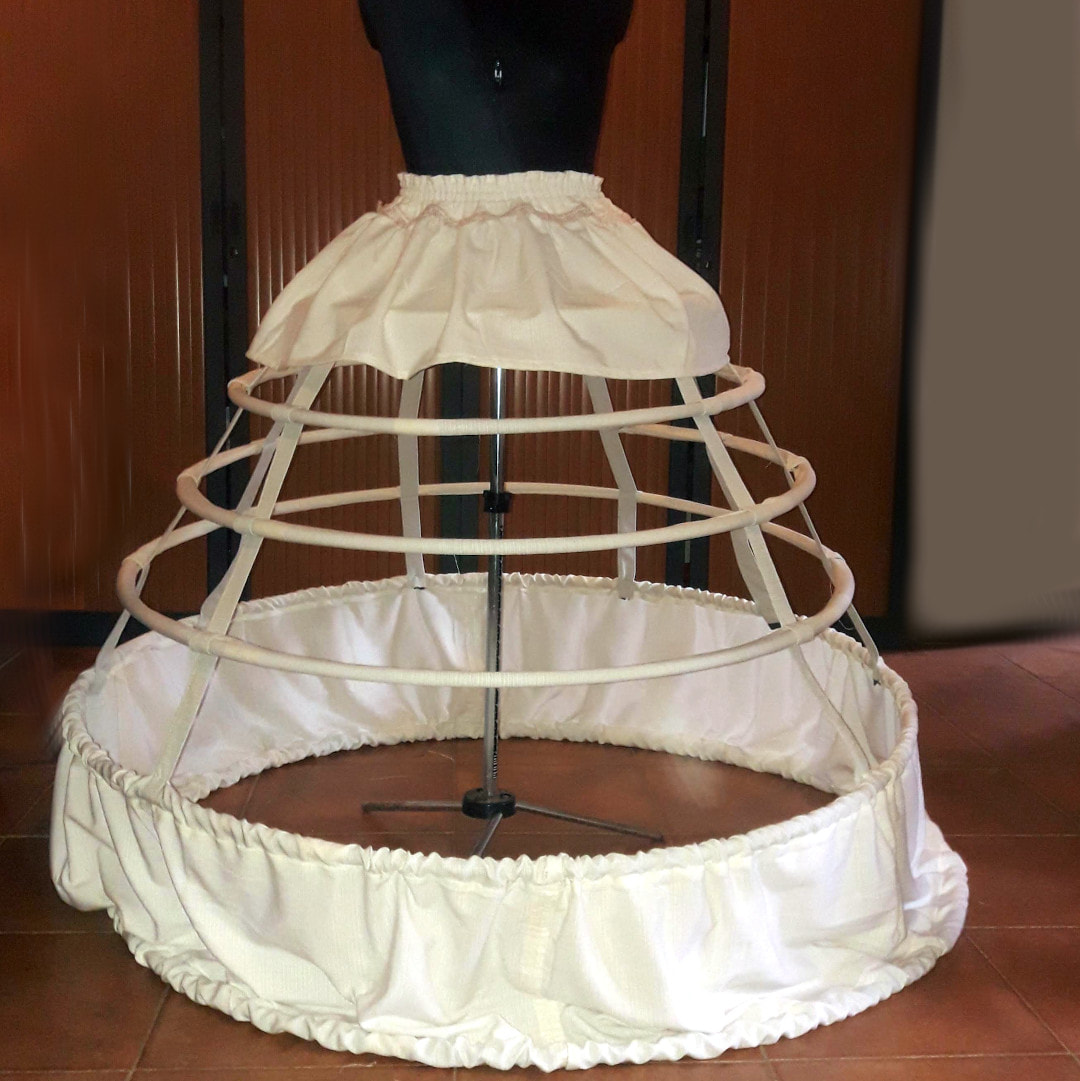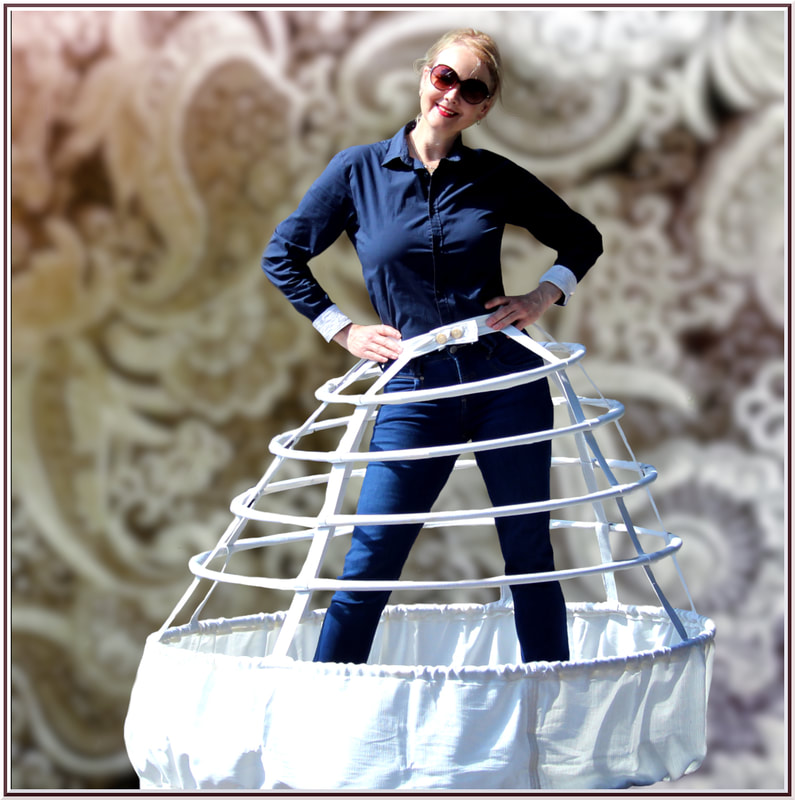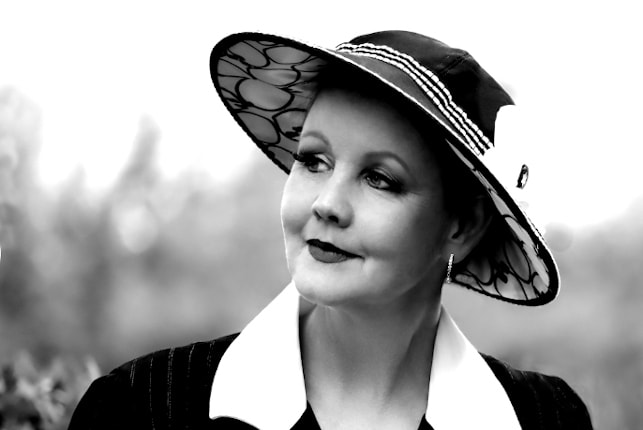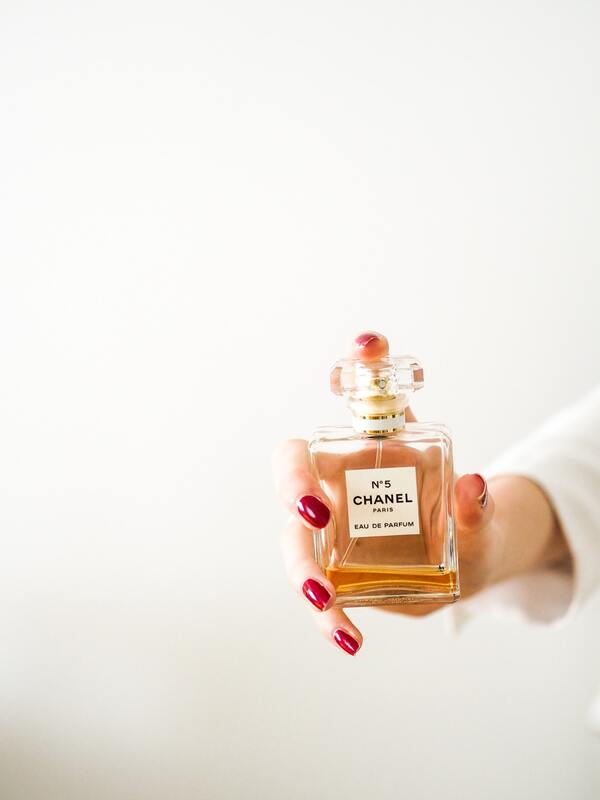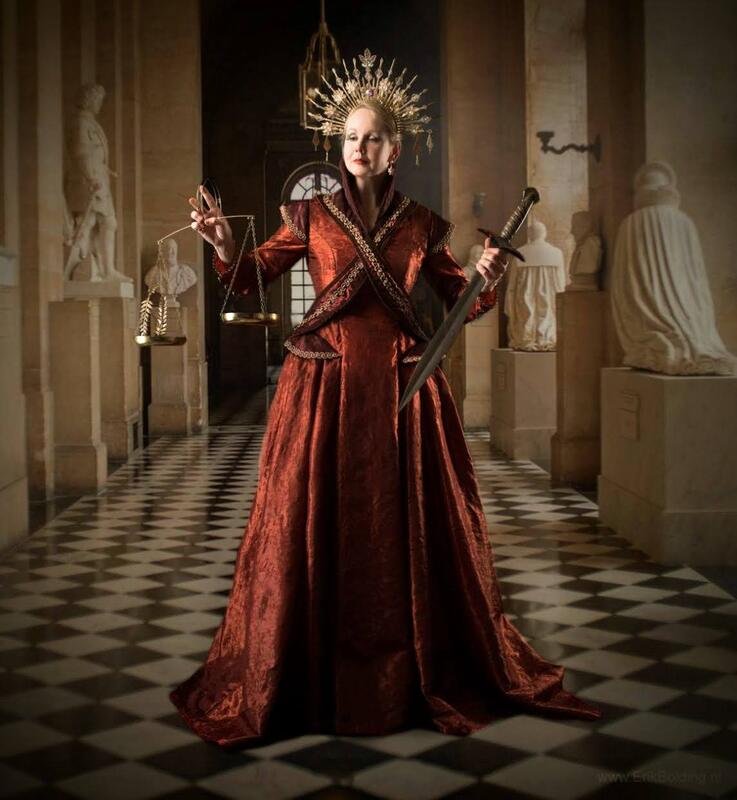|
For years, I have been following the Chanel fashionhouse. I read every book about Chanel or Chanel couture and I even create the famous Chanel jackets myself, according to the strict rules of Haute couture (and my beloved Claire Schaeffer). My quilty pleasure ... in capitals!
But now, a new book. A real treasure! You can hardly give a bigger gift to a Chanel-fan like me. Figuratively but also literally. Because it is a big book. A beautiful coffee table book with a striking light blue front and a very appealing content. But different than the others, because it stands out among all the glossy Chanel books, which have been on the coffee table for some time. The making of a Collection The book is richly illustrated by Jean-Philipe Delhomee. No illustrations as a side issue, but drawings that are at least 3 to 1 in relation to the text. No photo in this book, not even on the inside flaps of the cover and back page. The illustrations are beautiful, cheerful and very modern. The text of Laetitia Cénac is easy to follow in English for people our Dutch readers. Pleasant letter font, written well and clearly arranged. Who are the makers of a couture collection? Apart from all information about the Fashion House Chanel, about Gabrielle Chanel, history and even a list of important dates (pages 234-238), the book is mainly about WHO makes Haute-couture. Every step, from the process of idea (even an interview with Karl Lagerfeld) till the catwalk. The book is mainly about people who all do their work, which contributes to the beautiful couture collections of Chanel. The first pages are devoted to a fashion show. Before the first model with a beautiful Chanel jacket arrives on the catwalk, a lot has happened. Many people are already involved, who are an important part, but you have never thought about it for a second. Illustrations of the sound designer, the make-up artists, the fitting and dressing team, the stage manager etc. Presenting a collection is not a one-man show of a designer, but a well-oiled machine in which many people play a (big)role. The book elaborates on this. Back to the very beginning; from fabric to Haute couture. Every part of the collection and the entire making process is discussed, from bags, shoes, gloves, hats, jewelry to fabrics, yarn and threads. There are many pages dedicated to how the materials are made, how choices are made and where and who supplies this material. An ode to many people, to them all. To all people behind the products, to all people who cooperate or who are important suppliers of the basis for the Chanel collection. From now on I look at the Chanel collections with even more interest. A superficial world? Opinions are divided on this. The fact is that it is a whole industry and that more people are involved than you might think. A lot of glitter and glamor in this book, but strikingly enough, the emphasis is more on the entire creative process than on all the lavish luxury, the big money and the inaccessibility of Haute couture for ordinary people. This is mainly due to the modern, joy full drawings and the design of the book. Very well done, because in these times the environmental, climate and economic problems are too big to admit the money smelter of the upper class.
This book is an eye-opener that very cleverly emphasizes the old crafts, manual labor and all the people behind the scenes who do the work.
(Let's just hope that all these production processes will also be carried out in an environmentally friendly way and that they will be able to maintain themselves in the coming years. So that we can continue to enjoy the Chanel Haute couture) At least I have enough inspiration to climb behind the sewing machine ... if I manage to put this book aside for a while. As a seamstress you might wonder WHY you need an overlocker and WHICH overlocker.
We will answer loud and clear and help you to decide which overlocker works for you. An overlocker: yes, but why? First of all: it is not a sewingmachine. A (good!) sewing machine can do almost anything, but an overlocker is a the dessert after a delicious meal. The finishing touch, the whipped cream on the cake, the golden thread that makes your sewing work so professional finished. Do we know more metaphors? Probably, but let's stick to the (sewing) lesson. For example, an overlocker can sew elastic materials together and finish with a 3 or 4 thread-stitches without any difficulty. For example: these stitches at the end of a t-shirt. Turn your t-shirt or sweater inside out and take a look down. So now you know why! Even the best seamstress in the world can't get it done with a sewing machine. An overlocker sews and CUTS the fabric at the same time. So put those zigzag scissors away and from now on finish your own clothing with an overlocker. The result will be the difference between: "Nice jacket, mmm ... homemade?" And "Wowwwww, such a nice jacket. You are kidding me, did you make it really yourself ???” In addition, an overlocker also creates decorative seams, even threads beads or pearls on the fabric and is able to do a lot more magical tricks. And imagine you are working with a sewing machine to deal with a huge piece of fabric that should become a curtain: an overlocker would turn the big job into a piece of cake. But we won’t tell anyone, because you have just saved a huge amount of money by making your own curtains... Why do you need a lock machine? That's why. For all those things that an overlocker does and a sewing machine does not. Or maybe the sewing machine is able to the job but you need special feet. And above all: an overlocker is cutting and sewing at the same time. Now don't dump your sewing machine straight to the thrift store because with an overlocker in addition to a sewing machine, you create beautiful sewingwork and it definitely looks more professional. Which overlocker do you need? Overlockers are for sale in different price ranges. The cheapest is around 200-300 euros and the most expensive are around 1000 euros. The difference between the cheaper variants and the expensive ones is often in the fact that an expensive overlocker has an air pump threading system. The threads are blown through the machine, on the way to the end at the needles. This is especially easy for people who are less handy or who don't have the patience to manage the threading themselves. The expensive overlockers often have more options in terms of stitches and some options are automatically. The same as with a sewing machines. The more expensive the sewing machine, the more options and possibilities. Professional results Often the remark "Did you make it yourself..." does not feel like a compliment. Somehow people are noticing the difference between self-made clothes and the stuff you buy in a store. But as soon as you start working with an overlocker, you will no longer hear these words. Why not? Because your sewing work is now so precisely finished; it looks very professional! Let’s start adding beautiful labels with your own name or "self-made" on the clothes, because from now on, nobody believes it anymore. With an overlocker: your sewing work looks like Haute Couture Yourself. And "Oh wow, did you really make it yourself???" becomes a very big compliment! And you will answer very proudly: "YESSsss!" Vogue V9250 is a Claire Shaeffer designed pattern, published by Vogue. We know Claire Shaeffer from the books: The Couture Cardigan Jacket, Making Designers Trims and The Couture Skirt. In her books she describes how Coco Chanel designed her famous Chanel jacket, the faux-wrap skirt and other classics. The sewing pattern V9250 is an example of a classic Chanel jacket and completely focused on the couture sewing techniques. Vogue V9250 The vogue pattern is a pattern for a loose-fitting, lined jacket with princess lines, two-piece sleeves and many fringes. The fabrics for this jacket: Tweeds, Linen, Wool and crepe. It is advisable to stick to the fabric recommendation, although we have opted for a green summer bouclé. You will need buttons, shoulder pads and lots of extra fabric to make fringes. Sewing level: advanced The pattern has been titled "Vogue ADVANCED". We agree with this. Claire Shaeffer provides great detailed instructions, but you must have sewing experience to understand them. Also 'bouned buttonholes' are really only possible to make if you have a lot of experience. As a seamstress with a fair amount of sewing experience you can figure it out on your own, but make sure you can ask for help if you get stuck in the project or do not fully understand the instructions. Sewing-by-hand or 'Hand-sewing' As mentioned, a lot is work for this project is sewing by hand. You gotta love this. You can find the stitches you need in most books and on the Internet. Claire Shaeffer also explains it nicely, but first learn more about it. Sewing by hand is more than just basting, the stitches have to be really strong and above all demonstrable. The sleeves consist of two parts and we think the sleeves are quite narrow at the top. Make the pattern out of muslin first, to make sure it fits properly. Sleeves that are too narrow is really a pity. As a result, you cannot move comfortable in the jacket and there is even a chance that you will tear out, especially if you use delicate fabrics such as tweed and Bouclé. Claire Shaeffer's extra 'couture instructions' are very nice. This allows you to really learn to sew with couture techniques that you will enjoy later on. The instructions are "the secrets of the master". This way you can make a real couture jacket from an affordable pattern and fabric of your choice. We made the jacket from light green summer bouclé. The Bouclé fabric was light and not too loose. This Bouclé offers the possibility to easily make the fringes. Note: make the fringes from a double row of fabric. This gives a nicer effect and thus the fringes are easier to see. Use an overlocker to make a nice flat edge that you can easily sew onto the jacket. Or rather: between the different pattern pieces. The Chanel-style jacket has a classic look and is easy to combine with any kind of outfit. Green is not really a popular color, but it is certainly special, especially if you are looking for Bouclé fabrics in green tones. Everything about the color green & Chanel! Moreover, green is very easy to combine with jeans for a casual look, but also with black and white for a chic or business outfit. Pros:
Cons:
Summarized:
Vogue V9250 is a special sewing pattern to make the Chanel-Style jacket according to the vision of Coco Chanel and explained by Claire Shaeffer. (in the instructions for this pattern and in all of her books). The instructions are very comprehensive and clear. Yet this jacket remains a challenge for every seamstress. Keep this in mind if you don't have much experience with 'couture sewing techniques' yet. The sewing pattern is a Chanel-style jacket par excellence. Good luck ! As a fabric connoisseur, I like the concept of upcycling because fabric to me is like precious gold and diamonds to a jeweler. When I touch luxurious Italian silk and feel the softness of Spanish bouclé tweeds, I am fully aware of the many labour hours that go into weaving these beautiful textiles and in sewing the final garments. I understand why some fabric costs are higher and I can tell the difference between Haute couture and fast fashion ready-to-wear. The price point argument set aside, all clothing was made by someone somewhere. When I see the clothes purchased in heaps and discarded so effortlessly, as if all the work that went into them means nothing, I get frustrated. Upcycling in fashion involves taking old or used clothes or fabric and making beautiful garments out of them thereby giving them a new and hopefully more glamorous life. With determination and creativity, it is possible to make a stunning garment out of gently used clothing. I have recently made a trip to Value Village, one of the larger Canadian second-hand stores near me, in search of some interesting ideas for a potential upcycling project. The thrift stores in North America may be different from Europe, but the shopping strategies are the same. Let me share my ideas for finding beautiful fabrics in the thrift stores with you. #1: Know what you are looking for before you enter the store to avoid impulse purchases. As with any fashion collection, look for some inspiration first and you can even create a moodboard to get an idea of the general colours and textures that you like. Don’t go into drafting a pattern yet, because your choice of fabric will ultimately dictate the design. Are you going to make an upcycled evening gown, a glamorous day dress, or an unusual trench coat? (Alternatively, you may already have a pattern in mind, in which case you just skip this step. Pull the pattern out and read the fabric suggestions before going shopping.) #2: Shop alone or with a friend who shares your vision. I personally prefer to shop alone when I am looking for ideas for my design projects because at that point I am focused and I am in my creative zone. But if you have a generous friend who shares your vision and knows what you are looking for, she/he can be your second pair of eyes in spotting a bargain. (Don’t forget to show your gratitude and take your friend for lunch afterwards.) You and your friend can go to different parts of the store so you are not looking in the same spot and don’t feel bad if you want to go back and take a second look. Sadly, there are just so many clothes and it’s easy to miss a great find. If you frequent the same store often, you will probably notice the days of the week that the new items are put on the shelves and you can focus on shopping on those days only. #3: Don’t look for your exact size, but for one or more sizes bigger. The bigger the size, the more fabric you get to play with. The clothing section in the thrift shops here is usually huge, and some of the items there are brand new or worn only once, like wedding dresses. Look through the clothes in the dresses, skirts and tops sections. Although tops don’t have much fabric, you can still use them for patch pockets, decorative welts and accents. And what about using those for couture appliques and trims? Are there any fully functional long zippers or even corsetry boning pieces you can use? Those items are expensive if purchased brand new. At this point you have to have an open mind, look past the dated garment because you are not buying it to wear but to use it for something else. Focus only on the fabric and how its colour and texture fit your vision for the upcycled garment. A gorgeous guipure lace with beading (and lots of it!!!) all along the hem of a voluminous large-sized wedding dress which will give you plenty of material for lace trim or applique. On the right is an inspiration: upcycled wedding dress from Alexander McQueen Spring 2020 runway. On the left is a medium size dress with overlapped blue spangles from top to bottom. On the right is your inspiration: a lovely day dress with beaded collar and sleeves from Chanel Haute Couture Fall/Winter 2017 runway. On the right is a lovely velvet dress with a 12” zipper on the side and a metal belt. On the left is an inspiration: a blue velvet dress by Burberry from their Fall/Winter 2020 runway #4: Look for interesting prints, weaving patterns and/or fiber content. Always refer back to your mood board to stay on target in terms of your general colour theme. The sophisticated weaving patterns like jacquard and velvet are not that rare, and if you are lucky you can find some gorgeous twills and satins in the wedding/evening dress section or sumptuous knits in the women’s tops. And the more natural the fiber content in the piece, the better. Find the garment’s care instructions which will tell you the exact fiber content. 100% silk or 100% linen items are rare, but you can still find those. On the left is a large size dress with vertical rows of bright silver spangles on netting. These spangles would be great to use in gold work embroidery as well. On the right is an inspiration: a dress with generous embroidery throughout from Chanel Fall/Winter 2017, runway Also, check out the belts and scarves section. Many scarves are 100% silk or silk/cashmere mixtures. You can upcycle a wide silk scarf into a dress bodice, a beautiful summer tank top or sleepwear. #5: Hidden treasures in the drapery section. Depending on your project, you may find amazing yardage of fabrics in these sections. The store associates hang the fashion fabrics in this section. Unless you are an expert, you wouldn’t know if the fabric is made from natural fiber or not. Assume it is all polyester blends, trust your hand instead and feel the fabric. Is it rough and cold or silky and wonderful against your skin? Would you like to wear a garment made from this fabric? If in any doubt, put it back. #6: Most importantly, set your budget. And finally, be focused or you’ll end up picking up useless trinkets instead. Have a definite budget in mind. Are you going to spend $20 or $50? Your $4.99 and $8.99 purchases add up quickly, so hold your purse tightly and keep track of your items. You will have to make decisions on the spot because if you come back to the store tomorrow, the clothes you liked may not be there. Ask the store clerk about their return policies in case you change your mind. About the Author:
Elena Tran is a Canadian dressmaker and an entrepreneur passionate about haute couture sewing using beautiful fabrics and notions. After her career as a college administrator and mathematics professor, she pursued her interest in sewing and opened an online luxury fabric store baudekinstudio.ca. She is constantly learning and improving her craft. Her training includes lessons with the legendary couture instructor Angelina di Bello (Montreal, Canada), dressmaking program at Mohawk College (Hamilton, Canada) and online needlework courses at the Royal School of Needlework (London, UK). Organza fabric is a synthetic fabric woven with polyester and nylon. It is a very thin, transparent fabric, but because of the mix of the fabrics it is still very strong and very easy to sew. Organza is a cheap fabric and can be used for many sewing projects. The fabric is also extremely 'Haute couture' and chic. The two-tone organza is especially worth magic! The use of organza fabric Everyone has 'met' organza fabrics in their life. As a party decoration of flowers, in bridal clothing or draped around tables. Also for parties an festivals, the fabric is bought in bulk and used to decorate the cars up to beautiful costumes. And this fabric is used a lot for Cosplay and Fantasy costumes. A party fabric par excellence! But we also come across organza in everyday life, such as net curtains and furnishings for bedrooms. Also think of ribbons around gifts or decorations in flower arrangements. Despite the cheap image now, organza was once made exclusively from silk and acted as a super chic fabric for Haute couture. The former designers made the most beautiful evening dresses from organza. These were exclusive masterpieces. The fabric was and is also very popular for wedding dresses including decorations such as flowers. Organza & Haute Couture Organza is liked by designers for Haute couture. In the past but also today. We are talking here about the silk variant and not the synthetic one. Chanel used organza very recently in a beautiful dress. See: "LAYERS OF ORGANZA, FALL-WINTER 2020/21, HAUTE COUTURE, A story of transparency plays out in an organza cape" worn over a silk dress - the CHANEL Fall-Winter 2020/21 Haute Couture collection, photographed by Mikael Jansson . Organza is loved because of the possibility to process in many layers. From one layer: extremely thin and sophisticated (and sexy) to multiple layers that give shape and structure to the clothing. Don't confuse it with tulle. Tulle is more the cheapvariant and does not have the qualities that Organza does. You hardly see tulle in Haute couture. Organza is often combined with silk. A dress of pure silk and organza guarantees luxury and exclusivity. The fabric is mainly used as 'over-fabric' to give clothes extra mystery. Or a more luxurious look due to the transparent nature of the fabric. The fabric also provides movement, dynamics in the clothing. With the slightest movement or breath of wind, the clothing (extra) comes to life. LARP, Cosplay and Fantasy In LARP we hardly see the material. The fabric is delicate and hardly ever appeared in historical clothing. In terms of decoration, lace and velvet are more often used. Organza just does not fit in the total picture. Cosplay likes to work with the material. Think especially of wide skirts and Cinderella dresses. Despite the fact that tulle gives more effect, organza is a beautiful and chic addition to these costumes. Gothic and Steampunk prefer to work with tulle, as this gives it more strength and a more robust appearance. Although with organza more beautiful drapes can be made, such as black over fabric over a crinoline or red skirt. Organza is ideal for Fantasy. Especially the two-tone organza offers endless possibilities to make skirts, capes and dresses that have a beautiful mysterious and graceful effect. See the photos of Erik Bolding. A big advantage is that the fabric can be processed in many meters without the costume becoming heavier. The fabric also gives movement and light effects to the clothing. Events and Fantasy fairs are of course all about action, movement and posing for photos. Clothing of or processed with organza fabric is highly recommended, showstoppers! Tips & Tricks However, working with organza fabric can be a crime. The fabric is thin, slips under the presser foot and is difficult to make hems. The fabric is difficult to fold and seaming and finishing is not easy. Moreover, cutting the fabric is not a pleasant job either. The layers of fabric slide off each other and are difficult to lie on the table. Still it is doable if you follow these tips and tricks:
Summarized
Organza is a very beautiful fabric. The silk variant is truly sublime, but the synthetic fabric certainly also has its advantages in terms of price and the beautiful two-tone colors. The material is not that easy to work with, but you can avoid all frustrations by taking our tips and tricks to heart. Making a dress, cape, skirt or costume with organza may not be a party, but it is a party as soon as you see the result. The fabric is a real eye-catcher and worth all the extra time you have spent on it! Vogue V8804 is a Claire Schaeffer pattern published by Vogue. We know Claire Schaeffer from the books: The Couture Cardigan Jacket, Making Designers Trims and The Couture Skirt. In her books she describes how Coco Chanel designed her famous Chanel jacket, the faux wrap skirt and other classics. The V8804 sewing pattern is an example of a classic Chanel jacket and focuses entirely on the couture sewing techniques that make the jacket something very special. Vogue V8804 The vogue pattern is a pattern for a lined, quilted jacket. This means that the lining is attached to the outer fabric and is therefore not only Haute Couture, but also very pleasant to wear. The jacket is intended for the fabrics: Tweeds, Bouclé and Mohair, it is important to stick to these fabrics to create a real "Chanel Style" jacket. You also need an iron chain, buttons, trims or fringes and a beautiful silk lining. We recommend real silk, this makes sewing easier and is worth the investment. Average sewing level? The pattern is labeled "Vogue AVERAGE". However, we believe that it does require experience to create this jacket. You first need to prepare the pattern pieces separately (quilting the lining at the outer fabric) then you need to construct the jacket together. This also requires the necessary hand sewing experience. The instructions are comprehensive and clear, but it remains a complicated sewing project. Hand-sewing As mentioned, there is a lot of handsewing involved to creat this jaacket. You need to like this kind of sewing. Most books and the Internet have guides to 'do' the stitches you need. Claire Schaeffer also explains it nicely, but first try it yourself on small pieces of fabrics (leftovers). Sewing by hand is more than just basting, the stitches must be really sturdy and above all demonstrable. The sleeves consist of three parts and end in sleeve openings. Make sure you put the sleeves together well and keep in mind that they are very short. So adjust this in time if you want them longer. The inside of this jacket will eventually be just as beautiful as the outside. But take your time and practice on a sample first. It is also advisable to buy really nice matching yarn that is the same color as the lining. This sounds logical, but you often see that in clothing yarn is used that differs in color. This makes the garment suddenly a lot 'cheaper' in terms of appearance. Rather search a little longer for the right color than choose a color that you happen to already have at home. We made the jacket in black Bouclé fabric with a colorful lining (unfortunately you do not see this in the photos.) The Bouclé fabric was slightly heavier and firmer. The Chanel-style jacket has a classic look and is easy to combine with any kind of outfit. We also made the sleeves a lot longer. We also made the jacket in beige Bouclé. We have extended this jacket with additional edges around it in contrasting colors, just like the buttons. Read more about the beige color in Chanel's vision and the making of this jacket: Beige Bouclé Chanel-Style jacket. Pros:
Not so good:
Summarized:
Vogue V8804 is the ideal sewing pattern to make the Chanel-Style jacket according to the vision of Coco Chanel and explained by Calire Schaeffer. (in the instructions for this pattern and in all her books). The lining is sewn to the outer fabric (quilted) and has the appearance of Haute Couture in all respects. Take plenty of time to make this jacket. It will take longer than you think. But the result will undoubtedly be very beautiful and unique! A crinoline is a kind of underskirt construction that allows a skirt to be worn wide, very wide and extremely wide. In the 19th century, they were an important part of everyday clothing. Today they are made for costumes for movies, musicals and events such as the Fantasy Fair. However, for Cosplay, they are becoming increasingly popular. And don't forget the Gothic and Steampunk! A bit of history The garment was mainly worn by women between circa 1850-1870. Crinolines were used to give the shape of the clothes an increasingly wider ('more feminine') bell shape. The cage construction was made of smooth steel hoops that hung down from the waist and held by ribbons. The 'crinoline cage' turned out to be much lighter than wearing multiple layers of underskirts, as was previously used. The crinoline allowed an excess of fabric for the top skirt. The skirts took on increasing proportions. Meters of fabric decorated with ribbons, flowers and strips radiated luxury, fashion and wealth. Sometimes a skirt contained more than 40 meters of fabric and a huge amount of additives. The hours it took to make such a skirt were countless and priceless. The latter were mainly for the nobility and upper class. Social Distance Prints and drawings from the period show that the wearers of skirts with crinolines underneath could get (and possibly appreciate) the necessary space. The skirts created so much distance that women could barely speak to each other and men could not even touch the women. There is a print depicting a man offering the wearer of a skirt with crinoline a drink on an extended tray. The crinolines thus caused 'social distancing', the word that has become a well-known word in our century, a few months ago. However, the crinoline was also worn by women of the lower class and later even by every woman. It became a normal street scene despite the skirt making it almost impossible for women to move normally. The skirts took up a lot of space and caused problems on the street, in the church and indoors. In the 19th century, the crinoline slowly disappeared into the background and the shape of women's clothing became narrower and tighter at the waist. In the 1930s, courtiers attempted to reintroduce the crinoline. However, this failed. In Haute couture, crinolines are only seen under evening dresses, wedding dresses and costume films. Cosplay, Steampunk & Gothic In the Cosplay world we see the crinoline mainly as an underskirt for Japanese Animé. Ikoku Meiro no Croisée - 06 - Lost in Anime is a well-known example and Umi Sonoda sometimes wears short and sometimes wide blue skirts with a crinoline underneath. In Steampunk, the crinoline is often not intended as an underskirt, but the skirt becomes an over skirt. The construction is often very tough with leather straps and heavier steel hoops. Usually the skirt is medium long. The colors are black, brown or red. The crinoline is often combined with a tight-fitting waist corset so that the shapes come from full (shoulders) to narrow (waist) and super wide (the skirt). A Gothic crinoline is often long, down to the ground, always black or red, and is worn more like an underskirt. This is covered by a long shiny black skirt of a lot of fabric or tulle worn with a corset and the outfit is mainly finished with lots of lace, ribbons, bows and fringes. The Gothic appearance is mysterious, often showing 'the evil witch', 'the darkness' or 'lady evil'. The emphasis is on: black, blacker, black. How do you make a crinoline cage? You can make a crinoline cage yourself, but you will not be able to do it in one day. It takes a lot of time to find the materials together, to assemble the lines and the pipes through them. If you want to make a crinoline for an event, start at least three weeks in advance. Then you have plenty of time and you can also perfect the crinoline with decorations beautifully matched to the costume. Step 1: Choose the materials Get the PVC pipes depending on the sizes and the number of tubes you want to use. Cut them into four parts to be bent and joined together. Allow for a few centimetres for the spacers. Label each spacer so you know which hoop they belong to. This will make later construction much easier. In terms of fabric, it is best to choose a firm fabric but not too thick. For a Victorian crinoline, unbleached cotton would be very suitable. For a Gothic or Steampunk crinoline, we would recommend a black textured fabric. Step 2: Start with a waistband Make a waistband a bit more spacious and adjustable. Leave the bottom part of the waistband partially open so that you can sew the straps in here. You can also choose to make a waistband from thicker elastic or from an existing belt. For a fabric waistband, attach eight straps that are the length from the waist to the ground (or the desired height) plus 6 x (the number of tubes) x 7 cm. You need this extra space to make the loops. The width of your crinoline is up to you. The thinner the more graceful. The wider, the more robust. Step 3: Attach the hoops Coat the PVC pipes you precut earlier with fabric or use them as they are. Then slide the tubes through the fabric loops you made and attach the spacers to close the hoops. This is a difficult job where you can use an extra pair of hands. If you want to see the tubes but want a different colour, you could also paint spray the tubes or wrap them with tape. Step 4: Cover the top and the bottom of the crinoline Finally, make the bottom of an extra band of fabric (30 cm high) and possibly a skirt over the waistband. You can only sew the extra edge of the fabric with the two hoops (tubes) through it. It is an impossible job to put the total crinoline on a table and use the sewing machine for this. The crinoline is portable because it is foldable. You can also easily store the crinoline as it can be placed upright against the wall.
You can make a crinoline yourself. It is a sewing project that everyone can complete in their own way. Viewing a few YouTube videos in advance is a good plan. This allows you to see which method you like best. If you don’t have strong sewing skills, you can also purchase a sewing pattern which includes detailed sewing instructions. |
All about creating your own Chanel-Style jacket, Chanel-lovers information, Historic Costumes, Couture & Sewing book reviews and tutorials.
|
